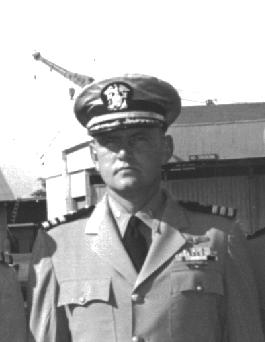|
Captain Gray was born in St. Louis, Missouri, on 18 July 1916. He attended schools in St. Louis and Houston, Texas. After attending Rice University for a period he enrolled in the United States Naval Academy and received a Bachelor of Science degree in 1940.
Captain Gray's first duty was in IDAHO (BB33) at Pearl Harbor. Following sub school in 1942, he participated in five successful submarine combat patrols against the Japanese. After hospitalization for a ruptured appendix in 1945, he rejoined Pacific Fleet as XO of CAIMAN (SS 323). While serving in CAIMAN, he met and wed Beatrice Castle Kirk DeGarmo, widow of classmate Edward E. DeGarmo; lost in action as a Torpedo Squadron Commander over Okinawa. DeGarmo sons, Alan and Edward, Jr., were adopted into the Gray family; with brothers, Patrick Erwin and Stephen Douglas, added in 1947 and 1953. After CAIMAN, Captain Gray entered law school at George Washington University. He was a member of the Law Review, received a Juris Doctor degree with honors, and was elected to the Order of the Coif upon graduation in 1949. Next came duty on Staff, ComSubForPac, as Flag Secretary and Force Legal Officer. During the Korean War, he made three patrols in command of TIRU (SS 416). After Armed Forces Staff College, he returned to sea in 1955 as XO FULTON (AS 11) in New London. He then served as ComSubDiv 101 (six fast attack submarines), followed by duty with ComSubForLant, as TacTra Officer, and Polaris Project Officer. In October, 1958, he was selected for duty as Military Assistant to the Chairman, JCS, and Special Assistant to SecDef.
He retired from the Navy in June, 1960, as Captain. Captain Gray joined the staff of Vice President Richard M. Nixon, Republican nominee for President. After Nixon's narrow defeat by John F. Kennedy, Captain Gray, Bea and their four sons returned to New London and the general practice of law. In January, 1969, he was appointed Executive Assistant to the Secretary of HEW. He was awarded the DSM with citation, "For his outstanding leadership, performance and dedication as Executive Assistant... His efforts exemplified the words No mission too difficult'." Captain Gray returned to his law practice briefly, but was soon requested to serve on the President's Cabinet Committee on Desegregation.
In December, 1970, Captain Gray was appointed Assistant Attorney General in Charge of the Civil Division. In 1972, the Senate Judiciary Committee reported his nomination to be Deputy Attorney General to the full Senate with a favorable 13 to 0 vote. Legendary FBI Director John Edgar Hoover died, and he was appointed Acting Director in May, 1972. During the next 51 weeks, he and Bea visited 58 of the 59 Field Divisions in order to oversee FBI operations at first hand and, following the later years' decline of the aging Hoover, bring the FBI into a new era. However, infighting between Republicans and Democrats following Nixon's "Watergate" forced Captain Gray's reluctant resignation from the FBI. He was later completely cleared of all charges of participation in the breakdown of the Nixon government, but during that contentious period, he considered it proper to respectfully decline election to the U.S. Naval Academy Alumni Association Presidency by his supportive Alumni associates and former shipmates. Following his resignation as Acting Director, FBI, Captain Gray returned to the practice of law in New London and Groton, Connecticut.
Captain Gray died in Atlantic Beach, Florida on 5 July 2005. He is survived by his wife, Beatrice Kirk Gray, and four sons: Edward of Lyme, N.H., Alan of City Island, N.Y., Patrick of Alpharetta, Ga., and Stephen of Grantham, N.H.
|
|
